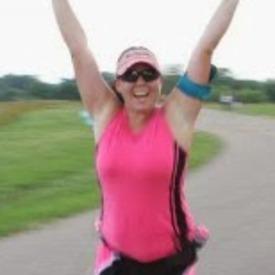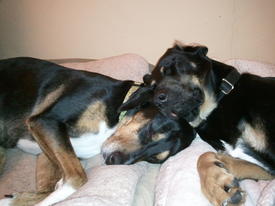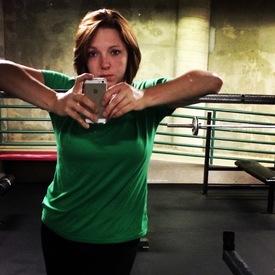Ways to avoid shin splints?

CatAriSal
Posts: 18 Member
I'm very prone to shin splints and they get excruciating pretty quickly. I've heard that gelatin is good for preventing and healing so I think I'll start incorporating bone broth into my meal plan, but what are some other good ways to avoid getting them?
0
Replies
-
Compression sleeves. I had a particularly bad bout with shin splints after increasing my milage too fast. I haven't had a problem since i started wearing my Zensah calf sleeves.0
-
you need to make sure you drink a lot of water and stand on the edge of a stair with about two inches of your toe still on the stair and lean back, you should feel the stretch. i had the same problem just make sure you keep stretching and drinking water! also don't push yourself further than you can go!
 good luck! 0
good luck! 0 -
Shin splints can also be caused by pronation (flat feet). Even if you don't have flat feet at rest, you may pronate while running which can cause the pain. Many times adding arch supports or just purchasing a quality shoe with good arch support can help if that's your problem. Otherwise not stretching your calves enough can cause shin splints. Make sure you are stretching your calves out really well AFTER running - prolonged holds of 20-30 seconds, two or three times on each side.0
-
you need to make sure you drink a lot of water and stand on the edge of a stair with about two inches of your toe still on the stair and lean back, you should feel the stretch. i had the same problem just make sure you keep stretching and drinking water! also don't push yourself further than you can go!
 good luck!
good luck!
You can use a wall as well. Angle your foot up and push into the wall using your calf. Make sure you stand tall when doing this.0 -
When I changed my shoes, mine went away.0
-
This exercise helped me SO much! Please try it.
1. Find some stairs. Actually, just one stair or a curb will do.
2. Turn so you're facing down the stairs. Scoot forward until just your heels are on the stair, with the rest of your foot hanging off (you can hold a wall or railing for balance).
3. With your legs straight, point your toes downward as far as you can, then lift them up as far as you can. Repeat.
4. Use a timer. Do as many as you can in 30 seconds. Do them rapidly, but with full extension and flexion.
5. After 30 seconds, bend your knees at a 45-degree angle (about half way). Without pausing to rest, do another 30 seconds of flexing in that position. That's one complete set. If it burns like hell, then you're doing it correctly.
6. Rest for a minute or two, then do another set—30 seconds with the legs straight, immediately followed by 30 seconds with the knees bent. Rest for a another minute, and repeat the two-part set.
7. Each day, do three of these two-part sets. The total daily routine includes 6 30-second sessions.
http://gizmodo.com/5902699/banish-shin-splints-forever-with-one-magical-exercise
Also, remember to ice them!0 -
Used to get them fiercely until I bought good walking/running shoes.....0
-
* Comfortable shoes. They make a huge difference.
* I run toe first now--my gait used to be heel first.
* Do not ramp up your speed and distances too quickly.
* Give yourself enough rest between exercise days to allow bones and muscles to rebuild.0 -
GOOD RUNNING SHOES!
Then you can try the sleeves and gels and stuff. it is also good start slowly with run/walk programs like C25K.
Good luck!0 -
When you run, land with your foot hitting the BALL of your foot, not the heel. Don't run on a hard surface if possible. Stretch. Don't jump into it right away. Try C25K if you haven't. I used it after not being able to run for 50 years, YES, 50 YEARS, and was able to do it without shin splints or side stitches! Yay. I actually enjoy running now. Good luck and I pray you stay pain free!0
-
Make sure you stretch to warm up before you walk/run, drink lots of water and stay hydrated, start out slow when you go for a run/walk each day and work up to your comfortable pace.0
-
I woud strongly suggest finding a GOOD running shoe shop. They often have a treadmill in the shop and will video you in some different shoes to see which ones you move in best. If you mention feet/anckle/leg problems they normally know which brands and styles would be best. DO NOT SKIMP ON YOUR SHOES REPLACE THEM AS NEEDED.0
-
REALLY good shoes! I had a huge problem with this in high school when i ran track. I understand how painful it is. I bought nice running shoes ( yes they were expensive) and they almost completely went away.0
-
I woud strongly suggest finding a GOOD running shoe shop. They often have a treadmill in the shop and will video you in some different shoes to see which ones you move in best. If you mention feet/anckle/leg problems they normally know which brands and styles would be best. DO NOT SKIMP ON YOUR SHOES REPLACE THEM AS NEEDED.
This. Good running shoes for you don't have to be expensive (mine are between 80-100 USD, which is often considered cheap), but you need to have the *right* shoes for your foot and the way your body moves. Not doing so can result in excruciating, movement inhibiting pain - not saying that your shin splints are necessarily caused by your shoes (likely culprit but there are also other causes), but when in doubt, shoes are the best fix. Even if you have the perfect shoes for your body, if you've got 500 miles on them it may be time for more. I've gotten 1400 miles out of some pairs, and only 300 out of others. YMMV, depends on your foot, terrain, and the shoe.
Compression socks, while expensive, are also amazing - and not just for shin splints. They seriously feel fabulous after long runs, and I know a lot of people who wear them flying. They come in pretty colors too (I have pink argyle).0 -
When I changed my shoes, mine went away.
Agreed - get properly fitted for a good pair of shoes (for whatever activity you are doing). It makes a world of difference.0 -
You have a lot of great suggestions so far but for me, keeping off the pavement (I will run on ANYTHING before pavement) and getting sorbothane inserts for my shoes fixed my shin splints and other issues (foot soreness, etc).0
-
A few things you can try. I've always been prone to getting them and recently when I started training for my marathon, I was coming from an extended break (I barely ran in 2012) so I was extremely worried since I was going to have a very aggressive training plan. I managed to avoid them though and I did the following:
1. Shoes! These are important. I discovered a couple years ago if I tried changing from my Mizuno Wave Inspires, I would get shin splints. I'm sure there are other shoes that are right for me out there but why bother looking if these work? So go to your running store that can analyze your gait and see if you need a different shoes. Don't skimp on shoes...they're really important.
2. Diet. Protein is hardly a problem for most people but I've never been a big dairy fan so my calcium intake has always probably been low. But for my training I needed a way to ensure my body could recover. I started eating for breakfast two servings of Greek yogurt. High in protein and calcium. Its my personal superfood. Shin splints are caused by either muscle or bone issues and if you experience very sharp pain, that is a serious sign of stress fractures which is the most serious form of shin splints. I think I usually have had that form as well and I credit my increased calcium intake with helping me avoid it.
3. Running surface. Sidewalks are the safest place to run to avoid traffic and the worst place for your legs. See if you can at least find a place to run on asphalt. A lot of my weekday training ended up on treadmills (not by choice, I hate them) and I think that putting about 1/3 - 1/2 of my mileage on such a giving surface was very helpful. If you can run on gravel or trails, it will help strengthen the rest of your leg muscles.
4. Strengthen your calves. Find some exercises to strengthen your calf muscles. If your calves are strong then they will help your legs absorb the shock of running much better and keep the bones of your leg from flexing as much which probably contributes to stress fractures.
5. Compression sleeves. I've also recently started doing most of my runs with compression sleeves on. I also usually wear them all day under my slacks at work. Any brand is good but I personally like the one I got called 110% because they incorporate pockets to hold ice packs.
6. RICE - Speaking of ice packs, just remember the RICE acronym. Rest. Ice. Compression. Elevate. If you feel shin splints coming on, as much as it sucks, you need to either cut back or stop running entirely. That's the rest part. Ice after every run. That's why I like 110%. As soon as I stop running I slip the ice in to my compression sleeves for 20 minutes. And then I ice 3 or 4 times a day if I can. Do this even if you don't have pain. Icing cuts down on swelling which is really how it starts. Compression also works by preventing swelling. It increases blood flow to your lower legs which aids in recovery. Elevation is the last part. You can do this while you ice...just try and lay down and keep your legs elevated to prevent blood from pooling in your lower legs.
You can also do things like take aspirin and ib profin (advil...). This helps with both pain and swelling. Swelling is the big danger. Tylenol will help with the pain but not the swelling so don't bother with it.0 -
Lots of good points already. Muscle related shin splints occur because, as the name says, the shin muscle is contracting to act as a splint for the leg. For some reason it finds a need to try and protect.
Shoes - cannot be overstated. Specialty running shop and let them help you find the best pair.
Form - You want to land gently nearly under your center of gravity. If you are slapping the ground with your foot, driving your heel or foot into the ground, overstriding (landing in front of your center of gravity) - all of those can contribute to shin splits. You want your landing to be soft and quiet.
Also - make sure your foot is relaxed going forward. If you are using your shin to pull your foot/toes upwards, that can contribute.
In other words, think relaxed in the lower leg. That can be hard sometimes - what is the natural reaction if you're worried something will hurt? You tense it, right? And that's the opposite of what you need to do.0 -
Form - You want to land gently nearly under your center of gravity. If you are slapping the ground with your foot, driving your heel or foot into the ground, overstriding (landing in front of your center of gravity) - all of those can contribute to shin splits. You want your landing to be soft and quiet.
I've had two coaches independently say precisely the same thing - "If you can hear your feet fall over your breathing, you're hurting yourself." Jogging with my flat-footed, "but I like these shoes"-fitting-resistant husband makes me cringe with every *SMACK* of a foot fall. If it sounds painful, it will be.
A friend sent me a link to goodformrunning, http://goodformrunning.com/learn-good-form-videos looks pretty helpful.0 -
I can't tell if anyone else added this but I found that "Down Dog " yoga pose really helps too (in addition to all the other good suggestions). Good luck!0
-
you need to make sure you drink a lot of water and stand on the edge of a stair with about two inches of your toe still on the stair and lean back, you should feel the stretch. i had the same problem just make sure you keep stretching and drinking water! also don't push yourself further than you can go!
 good luck!
good luck!
I had the same problem and did this ^ but also read up on it and heard changing your stride will help...it did for me.0 -
A lot of good info here. Here is my plan of attack (some if not all already mentioned)- in order of priority:
First; active recovery; Sub walking for a few days until the pain subsides; ice, elevate
1) Suspect your shoes and determine if you need new ones. That fit better and/or made for your gait and foot.
2) Tie some sort of weight (ex; 5 pound dumbell) under the ball of each foot. One at a time when sitting with your feet dangling over the edge raise your toes (exercising your shins) 2-3x to failure. Do this everynight and you will correct the muscle ratio imbalance.
3) Calf compression socks
4) stretching after your exercise
5) warming up (ex 5 min brisk walk) before your exercise
5.5) insert heel lifts under the insole of your running shoes
6) Get "The Stick" a rolling massager that you use before and after your run
7) Re-evaluate your running surfaces. Grass is best. Concrete (aka sidewalks) is the worst. On the weekends I go to a state park that has compacted dirt paths. During the week, if the ground is fairly dry I run on a ultimate frisbee field. If that fails I run on the road. Asphalt is softer than concrete (some say by a factor of 10X- I'm not so sure about that)
8) Re-evaluate your running form. Are you a heel striker?0 -
#2 and #5.5 throw up red flags for me. You're talking orthotics without prescription, and in the middle of an injury might not be the best time to start lifting weights for it (leave the weights out of the equation and I worry far less).
I'd also move 8 up to just below 1. Paying attention to your form is free, and will help you improve in a lot of different ways - it's like getting new shoes but for your whole body.
Short term you may find the most relief with #3.0 -
I am very prone to shin splints as well, something that I was told was attributed was that a face leg muscle above my knee's were inactive (not activating when running and add's additional strain to other surrounding muscles, electrostimulation at physio helped me for this)
I also have flat feet from wearing non-supportive shoes for years. My feet hit the floor flat when I run but they have a decent arch when not fully pressed against the ground. People like me need shoes that are specific to changing the rollout when you hit the pavement.
Also how are you striking when you hit the ground? Toe first, heel first or full foot and toe roll? If you are hitting with your heel first it can cause shin splints or related pain in the heel. Hitting with your full foot and then rolling off will help to reduce the chance of shin splints (and I can attest to this, I run this way now and have had far less injuries and occurences of shin splints since changing).
Proper stretching before and after are also important, getting the muscles in your legs ready and winding them down afterward is very beneficial.
http://www.livestrong.com/article/18797-stretches-shin-splints/
Livestrong has a great article that gives some tips on how to prevent with stretches 0
0 -
I have had terrible shin splints my whole life. Even as a kid, running just kinda hurt. I have high arches but I severely overpronate, in part due to weight.
Things that have finally helped:
* Strengthening my legs overall. I do a lot of leg exercises never focusing on just one muscle in my legs, but overall muscle development and balance. Things like working on squats with full range of motion (both at top and bottom of the squat) and making sure that my knees aren't collapsing in. My weight stays on the my heels and the outside of my foot.
* proper running form in correct shoes. I have switched to minimalist running shoes and have focused on developing a good mid-sole strike form in my run. I'm still not perfect at it, but the minimalist shoes help force the issue in some ways.
* KT Tape. Things were getting a lot better as far as my shins went, but I was still having pain when running or jumping rope. A friend recommended I try kinesiology tape and said that KT Tape had tape cut to the right length with video directions on how to best apply it. I tried it out and the difference it made was amazing. On the first application, my pain was reduced to a point it wasn't really bothering me during the activity. Within 3 weeks I was pain free. I still tape, but not all the time. Yes, it's not cheap, but if you get the pro stuff it can last a week. (I usually will leave it on for 5 days, just due to my workout schedule.)0 -
#2 and #5.5 throw up red flags for me. You're talking orthotics without prescription, and in the middle of an injury might not be the best time to start lifting weights for it (leave the weights out of the equation and I worry far less).
I'd also move 8 up to just below 1. Paying attention to your form is free, and will help you improve in a lot of different ways - it's like getting new shoes but for your whole body.
Short term you may find the most relief with #3.
LOL, a heel lift is not an orthotic! If it was then any shoe would be considered an orthotic as they all have different heel levels. You obviously would not weight train if you were in so much pain you couldn't walk. But, if you can walk and your pain is only when you run then this exercise will speed your recovery. At least it has for me and for every runner I know who has had shin splints.0 -
Most people talk about stretching the calf muscles but shin splints hurt............ well on your shins! To stretch that area, put your heels on the edge of a step, then lower your toes down as far as you can and hold. 3 sets of 20 to 30 second holds to start.
A.C.E. Certified Personal and Group Fitness Trainer
IDEA Fitness member
Kickboxing Certified Instructor
Been in fitness for 28+ years and have studied kinesiology and nutrition0 -
Rest heals them.
A slow and methodical build up to running and refraining from running on hard ground avoids them.0 -
Try to run on a mix of surfaces - not just roads (or worse, pavements). check your shoes, back off on your mileage and only increase slowly, don't overdo hill running, and stretch more than you think you need to after running. Your calves should be soft and supple at rest. If they're tight, you need to stretch more.0
-
oh yeah, and foam rolling - shins and calves.0
This discussion has been closed.
Categories
- All Categories
- 1.4M Health, Wellness and Goals
- 398.5K Introduce Yourself
- 44.7K Getting Started
- 261K Health and Weight Loss
- 176.4K Food and Nutrition
- 47.7K Recipes
- 233K Fitness and Exercise
- 462 Sleep, Mindfulness and Overall Wellness
- 6.5K Goal: Maintaining Weight
- 8.7K Goal: Gaining Weight and Body Building
- 153.5K Motivation and Support
- 8.4K Challenges
- 1.4K Debate Club
- 96.5K Chit-Chat
- 2.6K Fun and Games
- 4.8K MyFitnessPal Information
- 18 News and Announcements
- 21 MyFitnessPal Academy
- 1.5K Feature Suggestions and Ideas
- 3.2K MyFitnessPal Tech Support Questions























